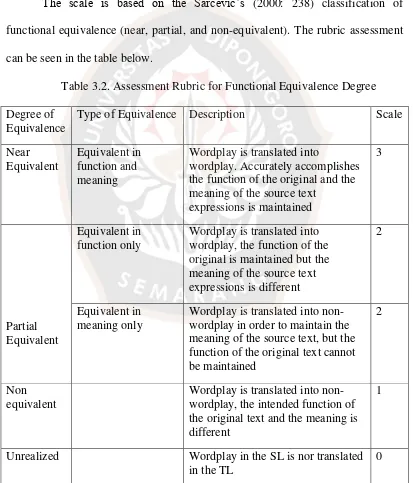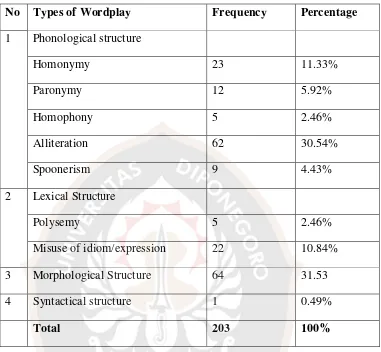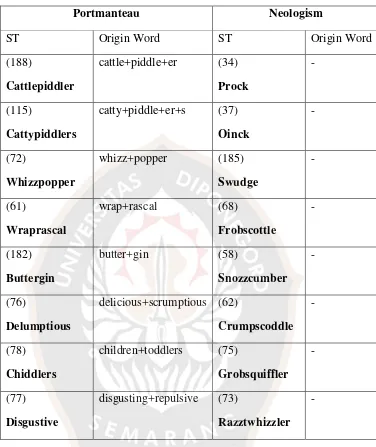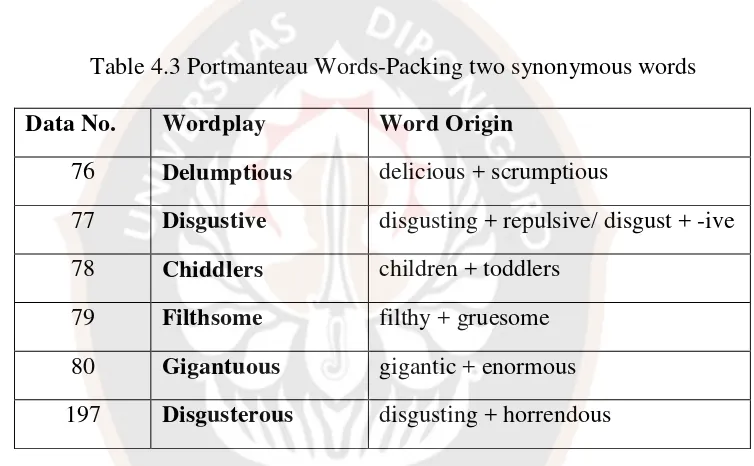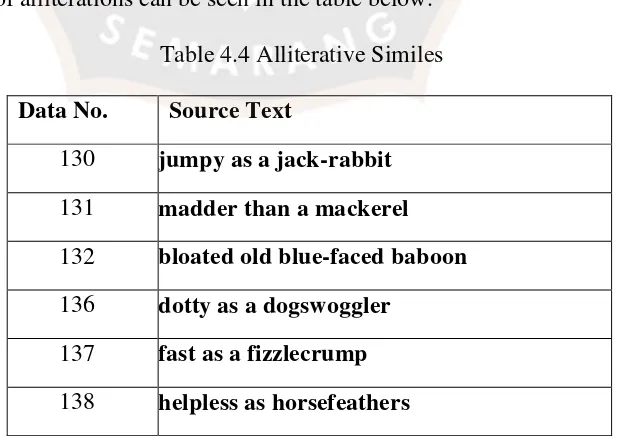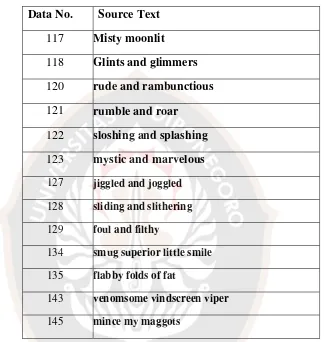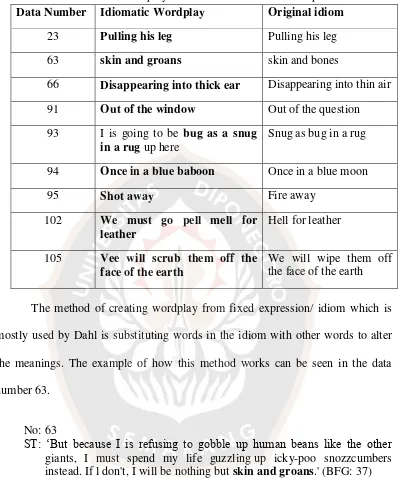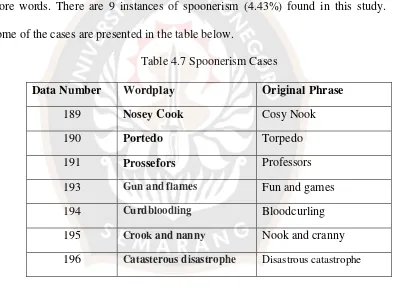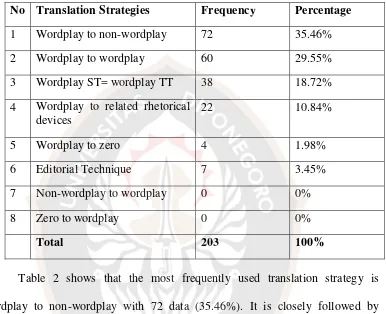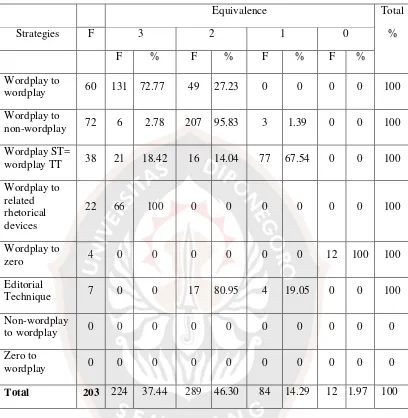i
STRATEGIES AND EQUIVALENCE OF WORDPLAY
TRANSLATIONS OF ROALD DAHL’S CHILDREN
BOOKS
A THESIS
In Partial Fulfillment of the Requirements For Master Degree in Linguistics
Muhsiyana Nurul Aisyiyah 13020213410034
FACULTY OF HUMANITIES
DIPONEGORO UNIVERSITY
iii
v
In the end, everything will be alright.
If it is not alright,
vi
vii
ACKNOWLEDGMENT
Alhamdulillahirobil’alamin
All praises and gratitude unto Allah, my All and my Everything. Peace and blessing be upon Prophet Muhammad SAW. There are also many people who supported me and made a year of writing this thesis fun, trying, exciting, and challenging. My deepest gratitude to:
1. Ministry of Research, Technology, and Higher Education (Ristek-Dikti Ministry) Republic of Indonesia for granting me BPP-DN scholarship and open the chance for me to advance my study.
2. Dr. Deli Nirmala, M. Hum., as the head of master program in linguistics and Dr. Nurhayati, M. Hum., as the secretary of master program in linguistics who gave me the golden opportunity to do this wonderful project.
3. Dr. Issy Yuliasri, M.Pd., this thesis would be utterly impossible if not for your extraordinary of kindness and guidance.
4. Dr. Agus Subiyanto, M.A., J. Herudjati Purwoko, Ph.D., Dr. Suharno, M. Ed., and all the lecturers of Master Program in Linguistics of Diponegoro University, thank you for all your valuable advices, motivation, and immense knowledge.
viii
6. My not so little brothers, Dany Firman Santosa and Widi Setyo Hutomo, for being the best brothers I could have. My little sister, Sheila Aleya Dina, for the laugh and all the sister-bonding stuffs you shoved me into. 7. Pratama Lysa Hapsari, for being the one I am proud to call a best friend
since we were in uni, thanks for laughing with me whenever crap happens, for all the fun and the laugh but not the tears (haha, we are too proud to let the other see each other tears or witnessing our most vulnerable moments) and most of all thanks for being the first reader and the proofreader of this thesis.
8. Nurvita Anjarsari, M.Hum, Aveny Septriani, M.Hum, Sabila Rosdiana, S.S, Dewi Rosnita, S.S., Wuri Sayekti, S.S., and Nur Laily Yusuf, S.S., for being the best friends I could have, for terrorizing me every time I don’t feel like writing, for the insights, and for the laughs and the zillion silly things.
9. Rahma Juwita, S.S., for all the laughs, all the bitter and sweet story, and for all the tales of your many adventures, and for being the rater of my research data.
10.Fadillah Sandy, Anisa Chairina, and Sri Suswanti, thanks for all the crazy stuffs, for all the fun, and the laugh, and the tears, and all the time we have spent together. Anna Primaningtyas, for being my weird sister in any sense. Yes, we the oddballs and the bluestockings and the nerds should stick together to talk forever about books, movies, and other useless stuffs.
Semarang, June 2016
ix
TABLE OF CONTENTS
TITLE ……… i
FORM OF APPROVAL ……… ii
CERTIFICATION OF ORIGINALITY……… iv
MOTTO………. iv
DEDICATION ……… v
ACKNOWLEDGEMENT ……… vi
TABLE OF CONTENTS ……… viii
LIST OF TABLES………... xii
ABSTRACT ……… xiii
INTISARI ……… xiv
CHAPTER I INTRODUCTION ……… 1
1.1. Background of research ……… 1
1.2. Research Question ……… 4
1.3. Objectives of research ………... 4
1.4. Scope and Significance of the study ……… 4
x
CHAPTER II LITERATURE REVIEW ……….……… 7
2.1. Previous studies ….……… 7
2.2. Theoretical Framework….………….……… 9
2.2.1 Wordplay ……….………... 9
2.2.2 Wordplay and Incongruity…..………... 12
2.2.3 Pun and Ambiguity………….……….. 13
2.2.4 Typology of Wordplay ………. 14
2.2.5 Humor in Translation ……… 20
2.2.6 The Translatability of Wordplay ……… 21
2.2.7 Equivalence ……… 22
2.2.8 Wordplay Translation Strategies ………... 26
2.2.9 The Life and Works of Dahl ………... 28
CHAPTER III RESEARCH METHOD ……… 39
3.1. Research Design ……… 39
3.2. Data and Source of Data ……… 40
3.3. Data Collection Method…….……… 41
3.4. Data Analysis Method and Procedure……… 44
CHAPTER IV FINDING AND DISCUSSION ……… 46
4.1. Findings ………….……… 46
4.1.1. Types of Wordplay ………….………..………. 46
xi
b. Alliteration……… 58
c. Misuse of Idiom……… 62
d. Homonymy ……….. 64
e. Paronymy……….. 65
f. Spoonerism……… 68
g. Homophony……… 69
h. Polysemy……… 70
i. Syntactical Structure……….. 70
4.1.2. Wordplay Translation Strategies and Their Impact on Equivalences…………..……… 71
a. Wordplay to non-wordplay strategy……….. 75
b. Wordplay to wordplay strategy……….. 80
c. Wordplay ST is wordplay TT……….... 86
d. Wordplay to related rhetorical devices……….. 89
e. Editorial Technique……… 91
f. Wordplay to Zero………... 92
4.2. Discussion…….……….……… 93
4.2.1. The significance of wordplays to Roald Dahl’s books……. 93
4.2.2. The Impact of Translation Strategies on the Translated Wordplay Equivalence………. 96
CHAPTER V CONCLUSION AND SUGGESTION………..……… 100
A. Conclusion ……… 100
xii
REFERENCES ………. 103
xiii
List of Tables
3.1. Questionnaire form of Degree Equivalence………. 42
3.2. Rubric Assessment of Functional Degree Equivalence…… 42
4.1.Types of Wordplay in Roald Dahl Books..……… 45
4.2.Portmanteau and Neologism Words……….. 47
4.3.Portmanteau Words-Packing two synonymous words………….. 51
4.4.Alliterative Similes……… 56
4.5.Two-word/three-word alliterations……… 59
4.6.Wordplay based on Misuse of Idiom/Expression……….. 61
4.7. Spoonerism Cases………. 67
4.8.Translation strategies for wordplay in Roald Dahl’s books…….. 71
xiv
ABSTRACT
This study focuses on the strategies and equivalence of wordplay translations of Roald Dahl’s books for children into Indonesian. The data were collected from the English and Indonesian versions of seven Dahl’s books using observation method with note taking technique. 203 instances of wordplay were found and then were classified based on Delabastita’s (1993) typology of wordplay and translation strategies. Three key informants were asked to rate the degree of translation equivalence as the secondary data for analysis support. The result shows that there are nine wordplay types found in Dahl’s books with wordplays based on morphological structure are in the highest rank (31.53%). It is closely followed by alliteration (30.54%), homonymy (11.33%), misuse of idiom/expression (10.84%), paronymy (5.92%), spoonerism (4.43%), homophony and polysemy (2.46%), and wordplay based on syntactical ambiguity (0.49%). It was also found that wordplays in Dahl’s books for children serve two functions; to produce humorous effect and break taboo. The translation strategy which was mostly used is wordplay to non-wordplay strategy (35.46%). 37.44% of wordplay instances were successfully translated into Indonesian with the same meaning and function as in the source text. In 46.30% of wordplay instances, the translators chose to preserve either the meaning or the function only. Meanwhile 14. 29% of wordplays are not equivalent both in meaning and function. 1.97% of wordplays were not translated or simply omitted by the translators.
xv
INTISARI
Penelitian ini membahas strategi dan kesepadanan penerjemahan wordplay dalam buku anak-anak karya Roald Dahl dari bahasa Inggris ke dalam bahasa Indonesia. Data dikumpulkan dari tujuh novel anak-anak karya Roald Dahl versi bahasa Indonesia dan Inggris menggunakan metode obervasi dengan teknik catat. 203 data berhasil dikumpulkan dan dianalisis menggunakan klasifikasi dan strategi penerjemahan wordplay dari Delabastita (1993). Tiga informan kunci diminta untuk menilai derajat kesepadanan penerjemahan wordplay sebagai data sekunder untuk mendukung analisis. Hasil penelitian menunjukkan bahwa terdapat Sembilan jenis wordplay dalam ketujuh buku Roald Dahl dengan wordplay berdasarkan morphological structure yang paling banyak ditemukan (31.53%) disusul oleh alliteration (30.54%), homonymy (11.33%), misuse of idiom/expression (10.84%), paronymy (5.92%), spoonerism (4.43%), homophony dan polysemy (2.46%), dan wordplay berdasarkan syntactical ambiguity (0.49%). Fungsi wordplay dalam buku karya Roald Dahl adalah untuk menciptakan efek humor dan mematahkan tabu. Strategi penerjemahan yang paling sering digunakan adalah strategi wordplay to non-wordplay (35.46%). Sebanyak 37.44% kasus wordplay berhasil diterjemahkan ke dalam bahasa Indonesia dengan makna dan fungsi yang sama dari teks sumbernya. Dalam 46.30% kasus wordplay, penerjemah memilih untuk mempertahankan makna atau fungsi saja. Sebanyak 14.29% terjemahan wordplay tidak sepadan baik fungsi maupun maknanya dan 1.97% kasus wordplay dihapus oleh penerjemah atau tidak diterjemahkan.
1
CHAPTER I
INTRODUCTION
1.1.
Background of the Study
Though more than fifty years have passed, numerous novels written by Roald Dahl (1916-1990) still enchant new generations of young as well as adult readers. Most of his books have been translated into various languages around the world and some have been made into widely popular films such as Charlie and the Chocolate Factory and The BFG. The popularity of Roald Dahl’s stories might lie in his talent to enchant
readers by a combination of adventure and his fascinating works on language which utilize amusing verses and clever sayings.
One of the most notable features of the language that Dahl used in his books for children is the great number of wordplays. These wordplays generally produce humorous effect to light up the mood of each situation. We can found his witty language in almost every page of his books that makes the stories even more playful and funnier. Wordplays have a great value in Dahl’s writing that it would be a serious loss to target readers if
they were ever lost in translation.
for the first time in 2006 and published by Gramedia Pustaka Utama. Dahl’s stories garnered wide attention from Indonesian readers after the movie adaptation release of Charlie and the Chocolate Factory in 2005 directed by Tim Burton.
Translating Dahl’s works is a challenging task for any translator. The target readers of Dahl’s books are children and translating children’s
literature is not as easy as it seems to be. The translator should take into consideration the characteristics of child readers; their interests as well as their level of reading and comprehension abilities. Another factor that makes translating Dahl’s books particularly challenging is the difficulty to preserve the funny-playful side and humorous effect created by wordplays which frequently found in the books. Chiaro (2005: 135) says that the translation of humor is ‘a notoriously arduous task the results of which are not always triumphant.’ In line with Chiaro, Diot in Vandaele (2010: 142) states that ‘when it comes to translating humor, the operation proves to be as desperate as that of translating poetry.’ The difficulties of wordplay translation, according to Chiaro (2005:137) are due to the fact that ‘the translation of humour manifestly touches upon the most central and highly debateable issues in translation study, those of equivalence and translatability’.
language because of the linguistic system differences. When dealing with wordplay which involves phonological structure (i.e. a homophone, a homograph, a homonym), for example, the possibility to find the same type of wordplay is extremely rare. Hence, when translating those types of wordplays, a translator is likely forced to compromise.
Chiaro (2005: 137) suggests that ‘as far as the translation of verbal humour is concerned, formal equivalence is sacrificed for the sake of dynamic equivalence.’ In other words, it is unavoidable to do some compromises as long as the wordplay in target language serves the same function as the wordplay in source language. Some features of the source text might be sacrificed in exchange for a gain in the target language.
Wordplay is, in fact, an inseparable part of Dahl’s writings. Wordplay, as discussed above, is closely related to certain characteristics of linguistic system of the source language and source culture which leads to equivalence and translatability issues when it comes to its translation. Certain strategies are also needed for its treatment. Therefore, translating Dahl’s works into other languages, including Indonesian, is a formidable
task.
characteristics that make reading books so much fun, often get lost in translations. Therefore, a research project about the translation of wordplay, a form of humor which is considered as a proper object of linguistic study, captures my interest.
1.2.
Research Questions
Basedon the statements above, two questions are addressed:
1. What are the types and significance of wordplay found in Roald Dahl’s books for children?
2. What are the translation strategies and their impact on the equivalence degree of the translated wordplay in the translation of Roald Dahl’s
books into Indonesian?
1.3.
Objectives of the Study
Based on the research problems, this study has two objectives:
1. To describe the types and significance of wordplay found in Roald Dahl’s books for children.
2. To describe the translation strategies applied to the wordplay translations in Roald Dahl’s books into Indonesian and their impact on the translated wordplay’s equivalence.
1.4.
Scope and Significance of the Study
the Great Glass Elevator, translated by Ade Dina Sigarlaki; The BFG, Danny the Champion of the World, and James and the Giant Peach, translated by Poppy Damayanti; The Witches, translated by Diniarty Pandi and Mathilda, translated by Agus Setiadi. Those seven books are considered as Dahl’s most popular works. With Delabastita’s (1993: 102)
typology of wordplay as a frame of reference, I would classify and then analyze what types of wordplay employed by Roald Dahl in delivering his quirky-witty-adventurous stories. Then, it concentrates on how wordplays are retained in the Indonesian translations based on Delabastita’s
translation strategies for wordplay
Translation studies are relatively new compared to other disciplines. Chiaro (2005: 135) states that ‘scholars of translation studies have, however, dedicated little energy to the subject of humour’. It is hardly surprising that there is not much works done in the field of wordplay translation, including in Indonesia. Theoretically, this work will enrich the knowledge of translation studies within the field of humour especially wordplay, no matter how small it is. Practically, the outcome of this study will be expected to give useful hints for improving the translation of wordplay.
1.5.
Writing Organization
background of the study, research questions, purposes of the study, scope and significances of the study, and writing organization.
Chapter II provides the literature reviews on previous studies related to this research, underlying theories on wordplay and its features employed on the analysis of this study. Chapter III describes the method, research design, unit of analysis, data and population, data collection, data analysis, and procedures of the research.
Chapter IV elaborates the result and discussion on the wordplay typology, translation strategies, and degree of translation equivalence of Roald Dahl’s works. Finally, chapter V provides conclusions and
7
CHAPTER II
LITERATURE REVIEW
2.1.
Previous Studies
Several studies have already been done in the area of wordplay translation. Perez (1999) explored the magical words of Lewis Carrol in his most popular works Alice in Wonderland and Through the Looking Glass. He analyzed how wordplays have been dealt with in the Galician
translation and Spanish translation of two Carrol’s novels. The result
yielded that generally, the translators choose to render the source text wordplay by a congenial target language wordplay whenever possible. If the congenial target language pun could not be found, they strive to produce a pun which, if it does not have the exact same meaning of the source pun, at least have a similar effect.
were due to linguistic system differences, especially because a suitable phrase preserving the pun could not be found in Finnish.
Korhonen (2008) ventured the field of multimedia translation. He conducted a study about the subtitling of wordplay in The Simpsons. The purpose of this study was to investigate what kind of translation strategies used by the translator to render the wordplays found in The Simpsons into Finnish. The result shows that the strategy mostly used by the translator is rendering the source text puns by non-puns and only less than a third of instances of wordplay was rendered into pun in the target language.
Herawati (2009) conducted a study about the Indonesian translation of wordplays in Donald Duck comic strips. The result yields that the difficulties in translating wordplays relate to the interplay of verbal and iconic elements in comic strips, cultural differences, and norm of translations.
Humanika (2011) investigated the Indonesian translation of wordplays found in Lewis Carrol’s Alice in Wonderland. He focuses on
Unlike the previous studies which treat wordplay as being synonymous with pun, this study follows Leppihalme’s (1997) and
Chiaro’s (1992) framework and treats pun as a subclass of wordplay.
This study does not only investigate humor instances with double senses, but it also covers those which do not have double senses. By treating pun as a subclass of wordplay, hopefully, this study has a wider coverage.
2.2.
Theoretical Framework
2.2.1. Wordplay
Almost in every attempt of defining wordplay, there is a question that always arises: do wordplay and pun refer to the same thing? There is not a consensus among scholars as to how to define and treat wordplay. Delabastita (1993: 56), for instance, considers pun being synonymous with wordplay. However, some researchers treated pun only as a subclass of wordplay. Leppihalme (1997: 42) refers pun to a subclass of wordplay, that of homophonous or paronymical types. Therefore, wordplay can be discussed in its narrow and broad sense. In its narrow sense, wordplay is treated synonymously with pun as suggested by Delabastita (1993: 56). Meanwhile, in a broad sense, wordplay is classed as an umbrella term covering all the subclasses, such as spoonerism and other linguistic units (Giorgadze, 2014: 271). The latter approach is used in this study.
the term wordplay has a wide coverage. It covers phenomena such as puns, spoonerisms, wisecracks and humorous stories.
Delabastita (1993: 56), on the other hand, defines wordplay as: Wordplay is the general name for the various textual phenomena in which structural features of the language(s) used are exploited in order to bring about a communicatively significant confrontation of two (or more) linguistic structures with more or less similar for ms and more or less different meanings.
There are some aspects that should be noted from Delabastita’s definition. First, wordplay is textual phenomena. Thus, wordplay needs to be used in particular textual setting or in another words, it requires particular context. Second, there are language features that can be exploited to create humorous effect. Delabastita explained in detail that the language features which can be exploited are phonological and graphological features, lexical feature, morphological feature, and syntactic feature. Third, another aspect of wordplay that should be noted is communicative significance. It is related to pun’s intentionality. A pun
can be said to be communicatively significant if and when it is intentional. Fourth, wordplay involves confrontation of two or more linguistic structures. It can be two or more linguistic structures resembling each other in form which are contrasted to create humor out of their different meanings. This confrontation of two senses is the aspect that differentiates wordplay in its narrow from its broad sense.
To illustrate how wordplay works, the example from Roald Dahl’s
“The human bean,” the Giant went on, “is coming in dillions of different flavours. For instance, human beans from Wales is tasting very whooshey of fish. There is something very fishy about Wales.”
“You mean whales,” Sophie said. “Wales is something quite different.”
The context of the example above is that the Big Friendly Giant was telling Sophie about the distinct taste of human from different country for human-eating giants. He told Sophie that the people from Wales tastes very fishy. Here, the linguistic structures which are contrasted are Wales and Whales. Both of them have similar forms but differ in meanings. According to Cambridge English Dictionary, “Wales” is a country that is part of the United Kingdom. It is pronounced /weilz/. Meanwhile, “whale” is a very large sea mammals that breathes air
through a hole at the top of its head. It is pronounced /weil/. Roald Dahl deliberately made it plural in order to make that word sounds similar to “Wales”. He exploited the phonological feature of the language to amuse
his readers. Dahl intentionally attached the word “fishy” to describe
“Wales” when logically, there is no relation at all between the two words. Instead, “fishy” is associated with “whales”.
Generally, the primary reason why a speaker or an author uses wordplay is to create humorous effect. It is intended to amuse readers or listeners. Delabastita (1996: 130) stated that aside from creating humorous effect and drawing reader’s or listener’s attentions to
forth. Recognition and appreciation of wordplay depends on reader’s
reading habit as well as the genre convention of the text. 2.2.2. Wordplay and Incongruity
Another important aspect of modern theories of humor is incongruity. Since wordplay is humorous, this theory is applicable to it as well. Velae (2004: 420) states that humor is a phenomenon that relies on incongruity. In other words, humor is produced by incongruity between what we know or what we expect, and what actually takes place.
According to Chapman and Foot (1996: 44) incongruity is a situation when what she or he expects differ from the fact experiences. Velae, Chapman and Foot basically have a similar view of humour and incongruity. Humour might arise because there is mismatch between ideas or object that have been thought with what really occurs on the joke, jest, gag, wordplay, or puns. An example from the famous commedian Robert Orben is provided in which the conflict between what is expected and what really occurs are obvious.
The world has so many problems that if Moses came down Mount Sinai today, two of the tablets he would be carrying would be aspirins.
When a punster says “Moses came down Mount Sinai with two
tablets”, the listeners expects to hear something like “two tablets of the
covenant law”. Instead they heard “aspirin” which was unexpected.
expected by the listeners and what he actually said. The item “tablets”
may well correspond to slates of stones, marble or rock as well as to drugs. Here, the punster exploited the two senses of the word “tablet” and
purposefully create incongruity.
Vandaele (1999: 148) states that incongruity occurs when cognitive rules are not being obeyed. In other words, there are violations, illogicality, incompatibility of expectation in every humorous instances, including wordplay.
2.2.3. Pun (A Subclass of Wordplay) and Ambiguity
According to Attardo (1994: 133) all scholars in the field of linguistic and humor studies agree that pun, a subclass of wordplay, involves two senses of a linguistic unit. This statement is quite similar to a linguistic phenomenon known as ambiguity. Leech (1969: 205) defines ambiguity as a phenomenon when the same piece of language have more than one cognitive meaning. Further, he supports his definition of ambiguity by providing Empson’s definition of pun. Empson defines pun
as any form of verbal nuance which ignites different responses to the same piece of language (Leech, 1969: 205). Pun and ambiguity definitely have one thing in common: the presence of more than one meaning. This notion evokes a question: what is the differences between pun and ambiguity?
Attardo (1994: 133) states that “words can be ambiguous outside of
two senses are in conflict”. Further, he describes that the two senses
involved in a pun cannot be random, but have to be semantically incompatible in the context. Any cases of ambiguity is not enough to create a pun. Delabastita (1993: 77) argues that there can be an overlap between pun and ambiguity. But then, the overlap is just partial. It is restricted to vertical pun only (where the second sense is not presented by the author or speaker; readers have to find out that second sense themselves).
Dynel (2009: 210) says that a pun is a humorous verbalization which has two interpretations couched in purposeful ambiguity of a word or a string of words. This opinion shows that ambiguity is the foundation of pun; the author or speaker deliberately uses ambiguous words to create humorous effect. Ambiguity in pun is always purposeful. Delabastita refers this intentionality of wordplay as communicative significance.
2.2.4. Typology of Wordplay
with some modifications. First, although this study uses Delabastita’s
typology, it treats wordplay in its broad sense. Second, in addition to Delabastita’s typology, there are two additional types of wordplay which can be exploited from phonological structure: spoonerism (Chiaro, 1992: 4) and alliteration (Welnick and Fisiak, 2008: 102). The four structural linguistic features that can be exploited to create wordplay are:
a. Phonological structure
When wordplays are based on phonological structure, wordplay is formed by words which share several phonemes or similar spelling without being semantically related. Delabastita (1993: 102) classifies that the relationships established between the components of a phonological wordplay can be in the form of homophony, homonymy, and paronymy.
Homonymy is a situation where two words or word groups are identical both in sound and spelling but differ in meaning. An interesting case of homonymy can be found in Lewis Carrol’s
Through the Looking Glass below:
“That would never do, I’m sure,” said Alice, “the governess would never think of excusing me lessons for that. If she couldn’t remember my name, she’d call me ‘Miss’, as the servants do.”
The words “miss” and “Miss” have exactly the same spellings and pronunciations but they differ in meaning. The first sense is “Miss” as the nominal designation and the second sense is
“miss” as verb. Homophony refers to a word or a string of words with
different spelling but identical in pronunciation. The example of this case can be seen from Lewis Carrol’s Alice’s Adventures in
Wonderland such as:
“I had not!” cried the Mouse, sharply and very angrily. “A knot!” said Alice. (Carroll: 17)
The word “not” and “knot” have the same pronunciations but they differ in spelling. When the Mouse said “not” what he truly
meant is “knot” but he twisted the word, exploited phonological feature, and create a pun.
Paronymy refers to words or group of words with nearly but not quite identical spelling and pronunciation. Below is the example of paronymy case which is taken from Alice’s Adventures in Wonderland.
“They were oblige to have him with them,” the Mock Turtle said; “no wise fish would go anywhere without a porpoise.” “Wouldn’t it really?” said Alice in a tone of great surprise. “Of course not,” said the Mock Turtle; “why, if a fish came to me, and told me he was going a journey, I should say ‘With what porpoise?”
“Do you mean purpose?” said Alice (Carroll: 155)
something is supposed to achieve) have only small differences in the spelling and pronunciations. The first is pronounced /pɔːpəs/ and the
latter /pɜːpəs/. In other words, “purpose” and “porpoise” are paronymous.
b. Lexical structure (polysemy)
Klein and Murphy (2001: 259) described polysemy as word that have several related senses. In other words, polysemy refers to a phenomenon in which a word have different but related senses. They give an example of polysemy case with the word “paper”. The word
paper can refer to both a thin flat material which is produced from pulp and a publication on that thin flat material. Senses of the same word are rarely ambiguous in context; but if the context is less specific, then the possibility of ambiguity is greater.
Delabastita (1993: 106) says that it is rather difficult to distinguish polysemy case from homonymy. Bergen (2008: 1) argues that polysemy is a condition where a words has multiple, related meaning, while homonymy happens when two, unrelated words, have the same form (spelling or sound). The example below can be considered to illustrate the concept of polysemy.
1)Simmon said “Grace, don’t postpone working on your paper. Tik tok. Your time is ticking.”
The word “paper” in the first and second sentence has exactly the same spelling and pronunciation, but the meaning is different. The word “paper” in the first sentence refers to a short piece of writing on particular subject. Meanwhile “paper” in the
second sentence refers to thin flat material made from crushed wood or cloth, used for writing, printing, or drawing on.
c. Lexical structure (idiom)
According to Delabastita (1993: 108), idioms are “word combinations with a sum meaning that is etymologically based on ... the combinations of their components meanings”. How idiom can be exploited to create puns is explained by Veisbergs (1997: 157). There are two way to create puns from idiom. The first one is structural modification. Idiom can be structurally modified by inserting, omitting, substituting words in the idiom in order to change its meaning. Delabastita (1996: 130) sees semantic modification as “the distance between the idiomatic and literal reading of idioms that gives the punster an opportunity for creation of a pun”. The following examples are illustrating structural and semantic modification of idiom.
Fred : Dude, be careful! Curiosity kills the cockroach. George : Aww! That hurts. I am not even a cat.
the word “cat” with “cockroach”. The correct form is “curiosity kills
the cat” which means being curious about other people’s affairs may
get you into troubles.
Jill : why don’t you start groveling in repentance for breaking my ancient Ming vase?
Jack : I’ll grovel when pigs fly, alright?
Jill : Honey, pigs cannot fly. Don’t you know that? They don’t have wings.
The example above demonstrates semantic transformation of an idiom. When pigs fly is a way of saying that something will never happen. Jill’s response to the idiom is based on a word for
word interpretation.
d. Morphological structure
Delabastita (1993: 109) states that wordplay can be created through morphological mechanisms, such as derivation and composition (or compounding). Delabastita (1996, 130) provides the following example:
Is life worth living? It depends upon the liver
The punster above used derivational development to create a new word. The word “liver” is constructed by adding suffix –er to the word “live”. The word “liver” is recognized in dictionary entry
but with totally different meaning
e. Syntactic structure
‘our girls sell well’. Here, it is unclear what the sentence actually
means. The sentence either tried to point out that call girls are in demand or it can also refer to literal meaning, for example, girls are good in sales.
2.2.5. Humour in Translation
Humour is regarded as one of text types that are most difficult to translate. Chiaro (2005: 135), for example, states that ‘verbally expressed
humour travels badly’. She argues that humour encounters two major translation barriers: different languages and different cultures. Vandaele (2010: 149) expressed the same thing: ‘humor is known to challenge translators’. Humor is often regarded as untranslatability case.
Further, Chiaro (2005: 138) says that the transposition from source language (SL) to target language (TL) will present the translator with a series of problems which will be both practical and theoretical in nature. Such difficulties are due to the fact that the translation of verbal humour manifestly touches upon the most central and highly debateable issues in translation studies, those of equivalence and translatability.
2.2.6. The Translatability of Wordplay
One issue of wordplay and translation that has been discussed by many researchers is whether wordplay is translatable or not. The translatability of wordplay is questioned because it depends strongly on the structure of source language for its meaning and effect. However, as Delabastita (1996: 131) points out, ‘languages differ in their structures, and thus different languages may well have different ways of creating wordplay. Some forms of wordplay may also be used in one language more than they are in another’.
Translating wordplay is a challenging task because language manifests itself in different ways from one language to another (Alexieva, 1997: 141). For instance, a word which have more than one meanings in English possibly has a corresponding word in Indonesian which has only one meaning.
certain language and members of certain culture will have their own perspective toward the world; perspective that differ from speaker from different culture and language. For example, a joke which is perceived as funny in English culture maybe does not always work in Indonesian culture. Although translating wordplay provides formidable challenge for any translator, wordplay cannot be said as untranslatable. Wordplay can be translated into other languages although the meaning will be different form the original wordplay and the context may also has to be adjusted to fit in the target language culture in order to be perceived as funny by the target readers.
2.2.7. Equivalence
The question regarded how much freedom a translator could apply in creating the same messages in the target text without neglecting any respect to the source text and the question on how a translator should overcome the translation problems due to different language systems has divided translators between those who are source text oriented and those who are target text oriented. Munday (2001: 19) says that ‘until the second half of the twentieth century, the problem in translation studies lies in the debate between literal and free translation’. In line with
text oriented favoured a translation which treats source text as a model in creating a new text in target text as long as it conveys the same message.
However, nowadays the new debate in translation studies has been emerged around certain key issues and one of the most prominent ones was that of equivalence (Munday, 2001: 19). Some translation scholar have attempted to define the nature of equivalence. Nida (2012: 149-153) classify equivalence into formal and dynamic equivalence. Later he replaced the term “dynamic” with “functional”. Nida explains that formal
equivalence focuses on the message itself in both form and content. The message in the receptor language should match as closely as possible the different elements in the source language. Further, Nida says that the message in the receptor culture should be constantly compared to the message in source culture. By doing so, what Nida calls “accuracy” and
“correctness” can be determined.
On the other hand, dynamic equivalence do not pursue the sameness in the form and meaning between source text and target text, instead it aims for an equivalence effect. Nida (2012: 151) states that there are three essential terms in his definition of dynamic equivalent, they are: (1) equivalent, which points toward the source-language message, (2) natural, which points toward the receptor language, and (3) closest, which binds the two orientations together on the basis of the
receptor language and culture as a whole, (2) the context of the particular message, and (3) the receptor-language audience.
Similar division was also proposed by Newmark. Newmark (1981: 38) proposes the term semantic translation and communicative translation. The main purpose of semantic translation is ‘to render, as
closely as the semantic and syntactic structures of the second language allow, the exact contextual meaning of the original text’. This concept is
similar to what Nida called as formal equivalence. Meanwhile communicative translation’s goal is “to produce on its readers an effect
as close as possible to that obtained on the readers of the original”. This
goal is similar to Nida’s dynamic equivalent.
The issue of equivalence is significant to wordplay translation because it deals with a very specific structural characteristic of the source language to produce its meaning and humorous effect. The nature of wordplay translation is so language specific and culture specific that the translator is likely forced to make extreme changes in the target text in order to preserves the original text’s communicative function or to retain the effect it has on the readers. Hence, the probability to achieve formal equivalence is very small. Fortunately, recent discussions on translation favor target text oriented approaches. For example, Skopos theory focuses on the intended function of the text (Vermeer, 1989). Nida’s
functional equivalence is directed primarily toward equivalence of response rather than equivalence of form. The target text is expected to have similar effect on its readers as the source text affects its readers. This approach is more suitable for wordplay translation. A case from Roald Dahl’s BFG is taken as an example:
He says Turks from Turkey is tasting of turkey
In this case, the issue of translationa equivalence becomes more intricate as the wordplay in question involves phonological structure. “Turkey” is a country in southeastern Europe and western Asia, a word which as well as having the meaning of a large bird grown for its meat. In Indonesia, the counterpart of “turkey” is kalkun which does not
resemble and relation to Turkey of a country in anyway. The Indonesian translator offers the following solution:
Bonecruncher bilang orang di Kamboja wanginya seperti bunga kamboja
“Turkey” and “turkey” is a pun instance which is based on the
sameness of pronunciation and spelling with entirely different meanings. The Indonesian translator substitute the word “turkey” with “kamboja”. In Indonesian, “kamboja” is a country in Southeast Asia (Cambodia), as
well as a kind of flower.
acceptable equivalence? It is crucial to translation because it is the unique intertextual relation that only translations, among all conceivable text types, are expected to show’. Further she explains that instead of assessing equivalence in absolute terms. The issue can be approached in terms of degrees of equivalence.
2.2.8. Translation Strategies for Wordplay
Translation strategy can be described as “the procedures (conscious
or unconscious, verbal or nonverbal) used by the translator to solve problems that emerge when carrying out the translation process with a particular objective in mind” (Molina and Albir, 2002: 508). Delabastita (1996) proposes eight translation strategies for wordplay, they are:
1. Pun to pun
The source-text pun is translated by a target-language pun, which may be more or less different from the original wordplay in terms of formal structure, semantic structure, or textual function
2. Pun to non-pun
The pun is rendered by a non-punning phrase which may salvage both senses of the wordplay but in a non-punning conjunction, or select one of the senses at the cost of suppressing the other; of course, it may also occur that both components of the pun are translated ‘beyond
recognition’
The pun is replaced by some wordplay-related rhetorical device (repetition, referential vagueness, irony, paradox, etc.) which aims to recapture the effect of the source text pun
4. Pun to zero
The portion of text containing the pun is simply omitted
5. Pun source text is pun target text
The translator reproduces the source-text pun and possibly its immediate environment in its original formulation, i.e. without actually ‘translating’ it.
6. Non pun to pun
The translator introduces a pun in textual positions where the original text has no wordplay, by way of compensation to make up for source-text puns lost elsewhere, or for any other reason
7. Zero to pun
Totally new textual material is added, which contains wordplay and which has no apparent precedent or justification in the source text except as a compensatory device
8. Editorial techniques
Explanatory footnotes or endnotes, comments provided in translators’
forewords, the ‘anthological’ presentation of different, supposedly
Delabastita treats wordplay in its narrow sense. He uses the term wordplay interchangeably with “pun”. This study adapts Delabastita’s
translation strategies for wordplay but with the broad sense of wordplay in mind. Thus, the term “pun” is changed into “wordplay”. The
translation strategies for wordplay used in this study are: The strategies are: (1) wordplay to wordplay (The source-text wordplay is translated by a target-language wordplay, which may be more or less different from the original wordplay in terms of formal structure, semantic structure, or textual function), (2) wordplay to non-wordplay (the wordplay is rendered by a non-wordplay phrase), (3) wordplay to related rhetorical device (wordplay is translated into repetition, referential vagueness, irony, paradox, rhyme, malapropism etc.), (4) wordplay to zero (the portion of text containing wordplay is simply omitted), (5) wordplay source text is wordplay target text (the translator reproduces the source-text wordplay and possibly its immediate environment in its original formulation, i.e. without actually ‘translating’ it), (6) non-wordplay to wordplay, (7) zero to wordplay, (8) editorial techniques (explanatory footnotes or endnotes, comments provided in translators’.
2.2.9. The Life and Works of Roald Dahl
reader. After graduating, he went to work for the Shell Oil Company in East Africa, and joined the Royal Air Force in 1939 when World War II began. Dahl then moved to the United States to help with the British war effort as assistant air attaché. He started writing short stories for literary
magazines. Dahl published the book James and the Giant Peach in 1961.
It was his first highly successful children’s book. In 1964, he released
Charlie and the Chocolate Factory, which went on to become his most
popular work. Over his decades-long writing career, Dahl wrote nineteen
children’s books and nine short story collections
(http://www.roalddahl.com/roald-dahl/timeline).
His other successful children’s books include Fantastic Mr. Fox
(1970), The Witches (1983) and Matilda (1988). The synopsis of the
Dahl’s books which are studied in this research are as follow:
1. James and the Giant Peach
Original Title : James and the Giant Peach
Publisher : Knopf Books
Publication date : 2010 (first published 1961) Indonesian title : James dan Persik Raksasa
Translator : Poppy Damayanti
Indonesian Publisher : PT Gramedia Pustaka Utama Indonesian Publication date: February 2010
Synopsys :
accident involving a rhinoceros. James’ life was miserable as he lived
Glow-worm became the light inside the torch of Liberty Statue. The Old Green Grasshopper became a member of the New York Symphony Orchestra. The Ladybird got married and had her ever after. Last but not least, James Henry Trotter lived inside the enormous peach stone and wrote a book about his amazing adventures.
2. The BFG
Original Title : The BFG
Publisher : Puffin Books
Publication date : 2001 (first published 1982) Indonesian title : Raksasa Besar yang Baik
Translator : Poppy Damayanti
Indonesian Publisher : PT Gramedia Pustaka Utama Indonesian Publication date: February 2010
Synopsys :
vegetable that grew in giant country. The BFG spoke in a very strange way and sometimes it took great effort for Sophie to understand him. Sophie happened to hear that all the human-eating giants went to hunt down humans all over the world. Horrified, Sophie wanted to stop the cruel human-eating giants for good. Then, she persuaded the BFG to approach the Queen of England and reported to her about the brutality of human-eating giants. The Queen invited them both for breakfast in the ballroom of the Buckingham Palace and gave orders to the Head of the Army and Head of the Airforce to follow the BFG to Giant Country with helicopters, captured the human-eating giants and bring them back to England. All of the human-eating giants were imprisoned in a pit. As a punishment they were fed nothing but snozzcumbers. A huge castle was built to reward the BFG. Next to his door, there is a little cottage where Sophie lived. The BFG learned proper English and wrote a book about his adventure with Sophie. Together, they lived happily ever after.
3. Charlie and the Chocolate Factory
Original Title : Charlie and the Chocolate Factory
Publisher : Puffin Books
Publication date : 2005 (first published 1964)
Indonesian title : Charlie dan Pabrik Cokelat Ajaib Translator : Ade Dina Sigarlaki
Synopsys :
an heir to inherit the factory for he has no children of his own. He invited Charlie and his family to live inside the factory.
4. Charlie and the Great Glass Elevator
Original Title : Charlie and the Great Glass Elevator
Publisher : Puffin Books
Publication date : 2005 (first published 1964)
Indonesian title : Charlie dan Elevator Kaca Luar Biasa Translator : Ade Dina Sigarlaki
Indonesian Publisher : PT Gramedia Pustaka Utama Indonesian Publication date: February 2010
Synopsys :
Willy Wonka gave the ownership of his chocolate factory to Charlie. Mr. Wonka invited all Charlie’s family member to live in the factory. They travelled from the Buckets’s cottage to Wonka
5. The Witches
Original Title : The Witches Publisher : Scholastic, Inc.
Publication date : 1997 (first published 1983) Indonesian title : Ratu Penyihir
Translator : Diniarty Pandi
Indonesian Publisher : PT Gramedia Pustaka Utama Indonesian Publication date: February 2010
Synopsys :
The Grand High Witch revealed her true appearance and made a speech about her plan to turn all the children of England into mice. The boy and his adventurous grandma stole the special mouse-making potion from the Grand High Witch’s hotel room, and
managed to pour it into the soup that would be served to all the witches during dinner time. All the witches turned into mice and were chased away by the hotel staff. The boy and his grandma devised a plan to get rid of all the witches around the world.
6. Mathilda
Original Title : Mathilda
Publisher : Puffin Books
Publication date : 1998 (first published 1988) Indonesian title : Mathilda
Translator : Agus Setiadi
Indonesian Publisher : PT Gramedia Pustaka Utama Indonesian Publication date: February 2010
Synopsys :
The only person who appreciated her extraordinary talent was Miss Honey, her teacher. One day, Matilda’s friend Lavender put a newt in Miss Trunchbull’s jug of water and when Matilda get blamed for it,
she discovered that she could make objects move with her willpower. She tipped over Miss Trunchbull’s glass of water. She found out that Miss Honey was actually the headmistress’s niece and had been ill -treated all her life by that horrible woman. Mathilda devised a plan to help Miss Honey. She pretended to be Miss Honey’s late father and
made the chalk wrote messages to Miss Trunchbull on a blackboard saying that she should leave Miss Honey alone and gave her back the house that was rightly hers. Miss Truncbull was scared out of her wit and moved away the following day. Matilda’s parents moved to
Spain because the police is after Mr. Wormwood. Matilda stayed behind and lived with Miss Honey.
7. Danny the Champion of the World
Original Title : Danny the Champion of the World
Publisher : Knopf Books
Publication date : 2002 (first published 1975) Indonesian title : Danny Juara Dunia
Translator : Poppy Damayanti
Indonesian Publisher : PT Gramedia Pustaka Utama Indonesian Publication date: February 2010
Synopsys :
filling station. His dad was his very best friend who never run out of wonderful stories to tell. One night, Danny discovered his father’s
deep dark secret: he loved to poach pheasants. Dad’s favorite place to
go to poach was Mr. Hazell’s wood. Dad loved to poach Mr. Hazell’s
pheasants because he was a terrible-arrogant man. Soon, Danny learned from his father all the strategy to poach pheasant such as The Horse-Hair Stopper and The Sticky Hat. Mr. Hazell’s annual pheasant-shooting party was approaching. It was a great event where Mr. Hazell hosted dukes, lords, barons, and other peerage. The night before the party, Danny and his dad soaked raisins with sleeping pill and gave them to the pheasants. They could poach 120 pheasants and hide them at the vicar’s house. The next morning, Mrs. Clipstone, the vicar’s wife, delivered the pheasants in an oversized baby carriage;
39
CHAPTER III
RESEARCH METHOD
This chapter describes the research method and research design of this thesis, as well as data and population used for analysis. This chapter also elaborates the used translation quality assessment tool, ways of collecting and analyzing data, and briefs the procedures of research.
3.1. Research Design
This study was conducted by using descriptive qualitative approach. Creswell (2014: 69) defines qualitative approach as “an approach for exploring and understanding the meaning individuals or groups ascribe to a social or human problem”. The result of qualitative research design according to Ary et al. is a narrative report, that you can understand the social reality experienced by the participants (2009:23). The problems described in this study are the wordplay types found in Roald Dahl’s books
for children and their significances. This study also discusses the translation strategies used in translating Dahl’s wordplays and the equivalence degree
of the translated wordplays.
children. Holmes in Sorvali (1996: 21) explained that pure translation studies has two main goals: descriptive and theoretical. Descriptive translation studies’ goal is to describe the phenomena of translating and translation(s) as they manifest themselves in the world of experience. Further, he classified descriptive translation studies into three types: 1) product oriented, 2) process oriented, and 3) function oriented. Product-oriented research focuses on the translation product, instead of the translation process. This view is based on the fact that from translation products, the data can be easily obtained and lingual unit that can be studied range from word level to textual level. The purpose of this study also varied. This study can be conducted to measure the translation quality, to reveal the types of translation, and to describe what strategies and approaches are adopted by the translator in dealing with equivalence issues.
3.2. Data and Sources of the Data
The source of the data in this study are 7 Roald Dahl’s books for children namely, Charlie and the Chocolate Factory, Charlie and the Great Glass Elevator, James and the Giant Peach, The BFG, Danny the Champion
There are two types of data in this study: primary and secondary data. The primary data are wordplays and their Indonesian translations in the form of words, phrases, clauses, and sentences. Analysis of the primary data will reveal what type of wordplay and what translation strategies are adopted by the translators to deal with wordplays.
The secondary data are the scale given by the raters. Three raters are asked to assess the equivalence degree of wordplay translation. The expert should have (1) proficiency both in Indonesian and English (scored 550 in TOEFL at the very least), (2) advanced knowledge of the translated text subject/field, and (3) experiences in technical concepts used in the translated text (Nababan, Nuraeni, & Sumardiono, 2012:50). The three raters assisting this research are Irfan Zahid Prasetya (a professional translator), Pratama Lysa Hapsari (an English-Indonesian interpreter and translator at a foreign company), Rahma Juwita (a diplomat at Indonesian Ministry of Foreign Affairs who is frequently in charge of interpreting and translating documents). The three of them meet the expert’s requirements
set by Nababan et al. The personal information of the three raters are enclosed in the appendix section.
3.2. Data Collection Method
Purposive sampling was used to select the data source and the data that fit this study’s objectives. In this case I deliberately chose seven books
non-participant observation method with note taking technique because the primary data were taken from written documents. The data collection was conducted by closely reading all the chapter of seven Roald Dahl’s books in their original versions and Indonesian translations, paid closer attention to wordplay instances, and wrote down wordplay instances on data cards. Below is an example of a data card.
63
ST: But because I is refusing to gobble up human beans like the other giants, I must spend my life guzzling up icky-poo snozzcumbers instead. If l don't, I will be nothing but skin and groans.' (BFG: 37)
TT: “Tapi karena aku menolak melahap tomat manusia seperti raksasa-raksasa lain, aku harus hidup dengan memakan snozzcumber yang rasanya bwahbweh ini. jika tidak, tubuhku akan menjadi tulang dan tumit saja.” (BFG: 50)
Table 3.1. Questionnaire Form to assess Equivalence Degree functional equivalence (near, partial, and non-equivalent). The rubric assessment can be seen in the table below.
Table 3.2. Assessment Rubric for Functional Equivalence Degree Degree of
Equivalence
Type of Equivalence Description Scale
Near Equivalent
Equivalent in function and meaning
Wordplay is translated into
wordplay.Accurately accomplishes the function of the original and the meaning of the source text
expressions is maintained
Wordplay is translated into wordplay, the function of the original is maintained but the meaning of the source text expressions is different
2
Equivalent in meaning only
Wordplay is translated into non-wordplay in order to maintain the meaning of the source text, but the function of the original text cannot be maintained
2
Non equivalent
Wordplay is translated into non-wordplay, the intended function of the original text and the meaning is different
1
Unrealized Wordplay in the SL is nor translated
in the TL
3.2. Data Analysis Method and Procedures
This study used referential method and translational method to analyze the data. According to Sudaryanto (2015: 14), the referential method’s definer tools are reality or any language referents. This method
was used to analyze the meaning of wordplay in its original context (source language) and its function. The wordplays, then, were grouped based on their types. Meanwhile translational method was used to analyze data which involves two distinct languages (Sudaryanto, 2015: 14). The main analysis of a translation study was focused on the target text (the translated text); the original text (source text) was used to refer, compare, and confirm the particular characteristics of the translated text in which the researcher is interested in. The main analysis of this study focused on the Indonesian translations of wordplays found in seven Roald Dahl’s books. The original text (the English text) was used to refer, compare, and confirm the wordplay translation strategies and the degree of equivalence.
translated text side by side with the English text as comparison. Each translation strategy is grouped and examine to find any particular pattern.
46
CHAPTER IV
FINDINGS AND DISCUSSION
In this chapter, the findings of the research is elaborated and discussed. All of the discussions in this chapter are aimed at finding answers to the research questions: what types and significance of wordplay were found in seven Dahl’s books (Charlie and the Chocolate Factory, Charlie and the Great
Glass Elevator, James and the Giant Peach, The BFG, Mathilda, Danny the
Champion of the World, The Witch); and what translation strategies were used and
their effect on the equivalence degree of the translated wordplay.
4.1. Findings
4.1.1. Types of Wordplay in Roald Dahl’s Books
Table 4.1. Types of wordplay in Roald Dahl’s books
No Types of Wordplay Frequency Percentage
1 Phonological structure
Homonymy 23 11.33%
Paronymy 12 5.92%
Homophony 5 2.46%
Alliteration 62 30.54%
Spoonerism 9 4.43%
2 Lexical Structure
Polysemy 5 2.46%
Misuse of idiom/expression 22 10.84%
3 Morphological Structure 64 31.53
4 Syntactical structure 1 0.49%
Total 203 100%
Table 1 shows that morphological development is in the highest rank with 64 data (31.53%) out of 203 total data. It is then followed by alliteration with 62 data (30.54%). Homonymy and Misuse of idiom/saying/expression are in the third and fourth rank with 23 data (11.33%) and 22 data (10.84%) respectively. Paronymy contributes 12 data (5.92%) while spoonerism contributes 9 data (4.43%). Polysemy and homophony contributes 5 data (2.46%) each and there is one instance of syntactical structure (0.49%).
information of data number. The discussion starts from the most to the least frequently appeared wordplay type. Wordplays are typed in bold.
a. Wordplay based on Morphological Structure
Wordplay can be formed through morphological mechanism such as derivation and compounding. Wordplay which is formed through morphological mechanism is the largest wordplay type found in Roald Dahl’s books with 64 data (31.53%) out of 203 data in total. Morphological mechanism forms made-up words which are mostly found in The BFG, Charlie and the Chocolate Factory, and Charlie and the Great Glass Elevator.
Table 4.2 Portmanteau and Neologism words neologism cases found in Dahl’s books. In portmanteau column, if the made-up words are dissected, there will be constituent words which are recognized in dictionary; for example, if wraprascal are taken apart, there will be “wrap” and “rascal” which exist in dictionary. Meanwhile in neologism column, even if the
divided into two parts, frob+scottle, the constituent words are still not found in the entries of any English dictionaries. The more thorough description and analysis of portmanteau and neologism cases are provided below.
No: 115
ST: The BFG sighed and shook his head firmly. 'I has told you five or six times,' he said, 'and the third will be the last. I is never showing myself to human beans.'
’why ever not?’ asked Sophie
'If I do, they will be putting me in the zoo with all the jiggyraffes and cattypiddlers’
This conversation is taken from the popular book The Big Friendly Giant where the two main characters are BFG, a friendly and kind hearted giant and Sophie, an orphaned little girl who traveled with BFG. Sophie and BFG were talking about the secret existence of giant race. Sophie asked why BFG never revealed his existence to human being. BFG said that if he ever revealed his existence, human would put him in the zoo with jiggyraffes and cattypiddlers. The context makes it clear that jiggyraffes and cattypiddlers are animals.
components, we can assume that jiggyraffes is probably a bad (or in this case, wild) animal which can move fast.
The similar operation also occurs on cattypiddler case. Cattypiddler are also strongly similar to the name of a real animal, “caterpillar”. Cattypiddler consists of two obvious unrelated words, catty and piddler. Catty can either refers to “cat-like” or “unkind” and to piddle means “to urinate” (www.dictionary. cambridge.org). There is a possibility that “a urinating cat-like animal” live in the zoo. Dahl delights his readers with an image of a cat-like animal piddling in a cage somewhere in a zoo.
Another example of portmanteau case is whizzpopper can be seen in the data below.
No: 72
ST: 'But with your drink,' Sophie said, 'what was it you called it?' 'Frobscottle,' said the BFG.
'With frobscottle,' Sophie said, 'the bubbles in your tummy will be going downwards and that could have a far nastier result.'
'Why nasty?' asked the BFG, frowning.
'Because,' Sophie said, blushing a little, 'if they go down instead of up, they'll be coming out somewhere else with an even louder and ruder noise.'
'A whizzpopper!' cried the BFG, beaming at her. 'Us giants is making whizzpoppers all the time! Whizzpopping is a sign of happiness. It is music in our ears! You surely is not telling me that a little whizzpopping is forbidden among human beans?'
thought that even with bubbles that travel upward, one would occasionally blech after drinking coke. What if one drank frobscottle with bubbles that travel downward? Drinking frobscottle could have nastier result. BFG said that after drinking frobscottle, giant always do whizzpopper.
If the word whizzpopper is taken apart, there will be two main components: “whizz” and “pop+er”. “Whizz” is “to move or do something very
fast” and “pop” is “a short, sharp sound like something exploding”
(www.dictionary Cambridge.org). The context and the meaning of its components, make it clear that whizzpopper is a term used for noisy and loud farts brought on by drinking frobscottle. Dahl delights children with this made-up word because it clearly refers to something that they are usually told it is impolite to discuss. Children tend to love digestive related joke like burp, blech, and farts. Dahl coined a new word to deliver his jokes and break taboo without getting into trouble.
Data number 183 is also an interesting case of portmanteau which is formed through compounding mechanism.
No: 183
ST: BUTTERSCOTCH AND BUTTERGIN, it said on the next door they passed.
